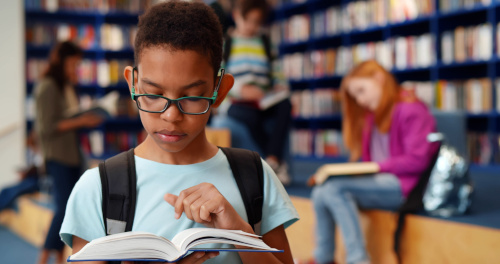While I’m a far cry from a Newbery, once a year, I’ve gotten into the habit of writing a picture book for my nephew Knox. My goal is to keep the eight-year-old excited about reading, because what little boy doesn’t want to read a book about himself?
For the purposes of this article about using picture books in instruction, I invite you to listen as I read aloud to you The Great PunkaKnox.
When I was in school, my teacher would have read the book out loud and asked us questions to test our comprehension, such as:
Q) Who did Knox live with? A) His aunt and uncle.
Q) What color was Knox’s pumpkin? A) Green.
Q) What animal visited Knox’s pumpkin? A) A fox.
A slightly more sophisticated question might be:
Q) Who is the narrator of the book? A) The pumpkin.
In “old school” school, teachers would pass along information; students would listen, memorize, and regurgitate. Fast-forward (yes, a 1980’s VCR reference is highly appropriate) a few decades, and students today have answers to every question in the world with a click or a swipe. Content and information are readily available to everyone; therefore, standing at the front of the classroom and sharing information is no longer an effective form of instruction.
Yet, books have never been a more important delivery tool.
In a recent webinar, Using Books as Mentor Texts, teacher and author Adrienne Gear shared, “The books are my teaching partners to get to deep thinking. You don’t have to be a proficient reader to be a proficient thinker.”
In a world where answers are at our fingertips, Gear says, “Teachers are now faced with the challenge of helping students think more deeply by being content connectors rather than content givers. No longer are Ivy League schools looking for young people who can regurgitate facts to get A’s. Universities and eventually employers are looking for deep thinkers, problem solvers, and people who understand how to work collaboratively.”
Using Gear’s instructional philosophy, let’s, “Pause and ponder,” on what background knowledge students could take away from The Great PunkaKnox over and above the simple comprehension questions listed above.
Students may have never been exposed to a garden. The story provides an opportunity for teachers to help students develop background knowledge on gardening and farming. Teachers could develop an entire lesson on grocery store supply chain and how food gets to your table.
Students may not see food cooked from scratch at home. Growing up in my house, the pumpkin pie came from the bakery! Perhaps a writing and discussion activity could be for students to share their favorite meal and talk or journal about how they believe it’s prepared and cooked.
Students may have never thought about why pumpkins come in different colors. Which is a perfect way for a teacher to infuse the science of cross breeding and cross-pollination into the conversation. Art could be infused into the lesson by asking students to turn their pumpkin into something new like Knox’s green M&M.
To connect with students on a social and emotional level, a teacher could ask students to talk about why Knox may have come to live with his aunt and uncle* and why he may have eventually moved away to Texas. Knox’s story is an example that family comes in many shapes and sizes. And often little ones must adapt to new environments and even new caretakers.
Gear also suggests choosing a book that has a theme that connects to one word. Before reading a picture book, Gear asks students what they think about when they see a particular word. Using The Great PunkaKnox as an example, a teacher could use the word TOUGH. Before reading the book, students would probably liken TOUGH to muscles and super-heroes. After reading the book, they might recognize that seeds and little boys are TOUGH AND can withstand a lot—even cold Woodstock, Illinois winters and time way from their mom and dad.
While I used my own little story to illustrate how picture books can be used as mentor texts, Gear highlights many fantastic examples in her webinar, using books you likely already have in your school library. School librarian Tom Bober has an entire blog series where he shares picture books that can be used as primary sources for historic topics like the Tulsa Race Massacre.
In the end, the words and pictures on the page are in their simplest form. But students will remember the lessons that can emerge from those words and pictures, long past the test, as we use these stories to prepare young ones for life.
Now, time to make a pumpkin pie.
*While not pertinent to The Great PunkaKnox’s storyline, you may be curious about the backstory. In 2018, Knox’s dad Ryan was critically injured in Afghanistan, losing three limbs. In the months that followed, Knox lived with my husband and me while his dad recovered. Knox eventually reunited with his mom and dad in Texas. Yet his pumpkin patch lives on, has yielded many yummy pies, and is a few months from sprouting its third season!
- The making of a literary award winner - November 25, 2024
- Dog Man vs. To Kill a Mockingbird - August 19, 2024
- Boycotting book fairs no more - May 27, 2024

